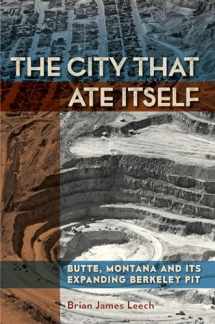
The City That Ate Itself: Butte, Montana and Its Expanding Berkeley Pit (Volume 1) (Mining and Society Series)
ISBN-13:
9781948908290
ISBN-10:
1948908298
Edition:
1
Author:
Brian James Leech
Publication date:
2019
Publisher:
University of Nevada Press
Format:
Paperback
376 pages
FREE US shipping
Book details
ISBN-13:
9781948908290
ISBN-10:
1948908298
Edition:
1
Author:
Brian James Leech
Publication date:
2019
Publisher:
University of Nevada Press
Format:
Paperback
376 pages
Summary
The City That Ate Itself: Butte, Montana and Its Expanding Berkeley Pit (Volume 1) (Mining and Society Series) (ISBN-13: 9781948908290 and ISBN-10: 1948908298), written by authors
Brian James Leech, was published by University of Nevada Press in 2019.
With an overall rating of 4.0 stars, it's a notable title among other
Energy & Mining
(State & Local, United States History, Historical Study & Educational Resources, Industries) books. You can easily purchase or rent The City That Ate Itself: Butte, Montana and Its Expanding Berkeley Pit (Volume 1) (Mining and Society Series) (Paperback) from BooksRun,
along with many other new and used
Energy & Mining
books
and textbooks.
And, if you're looking to sell your copy, our current buyback offer is $3.97.
Description
Winner of the Mining History Association Clark Spence Award for the Best Book in Mining History, 2017-2018
Brian James Leech provides a social and environmental history of Butte, Montana’s Berkeley Pit, an open-pit mine which operated from 1955 to 1982. Using oral history interviews and archival finds, The City That Ate Itself explores the lived experience of open-pit copper mining at Butte’s infamous Berkeley Pit. Because an open-pit mine has to expand outward in order for workers to extract ore, its effects dramatically changed the lives of workers and residents. Although the Berkeley Pit gave consumers easier access to copper, its impact on workers and community members was more mixed, if not detrimental.
The pit’s creeping boundaries became even more of a problem. As open-pit mining nibbled away at ethnic communities, neighbors faced new industrial hazards, widespread relocation, and disrupted social ties. Residents variously responded to the pit with celebration, protest, negotiation, and resignation. Even after its closure, the pit still looms over Butte. Now a large toxic lake at the center of a federal environmental cleanup, the Berkeley Pit continues to affect Butte’s search for a postindustrial future.
Brian James Leech provides a social and environmental history of Butte, Montana’s Berkeley Pit, an open-pit mine which operated from 1955 to 1982. Using oral history interviews and archival finds, The City That Ate Itself explores the lived experience of open-pit copper mining at Butte’s infamous Berkeley Pit. Because an open-pit mine has to expand outward in order for workers to extract ore, its effects dramatically changed the lives of workers and residents. Although the Berkeley Pit gave consumers easier access to copper, its impact on workers and community members was more mixed, if not detrimental.
The pit’s creeping boundaries became even more of a problem. As open-pit mining nibbled away at ethnic communities, neighbors faced new industrial hazards, widespread relocation, and disrupted social ties. Residents variously responded to the pit with celebration, protest, negotiation, and resignation. Even after its closure, the pit still looms over Butte. Now a large toxic lake at the center of a federal environmental cleanup, the Berkeley Pit continues to affect Butte’s search for a postindustrial future.


We would LOVE it if you could help us and other readers by reviewing the book
Book review

Congratulations! We have received your book review.
{user}
{createdAt}
by {truncated_author}


